Best no-code platforms of 2025
Use these best no-code platforms to create mobile and web apps with ease
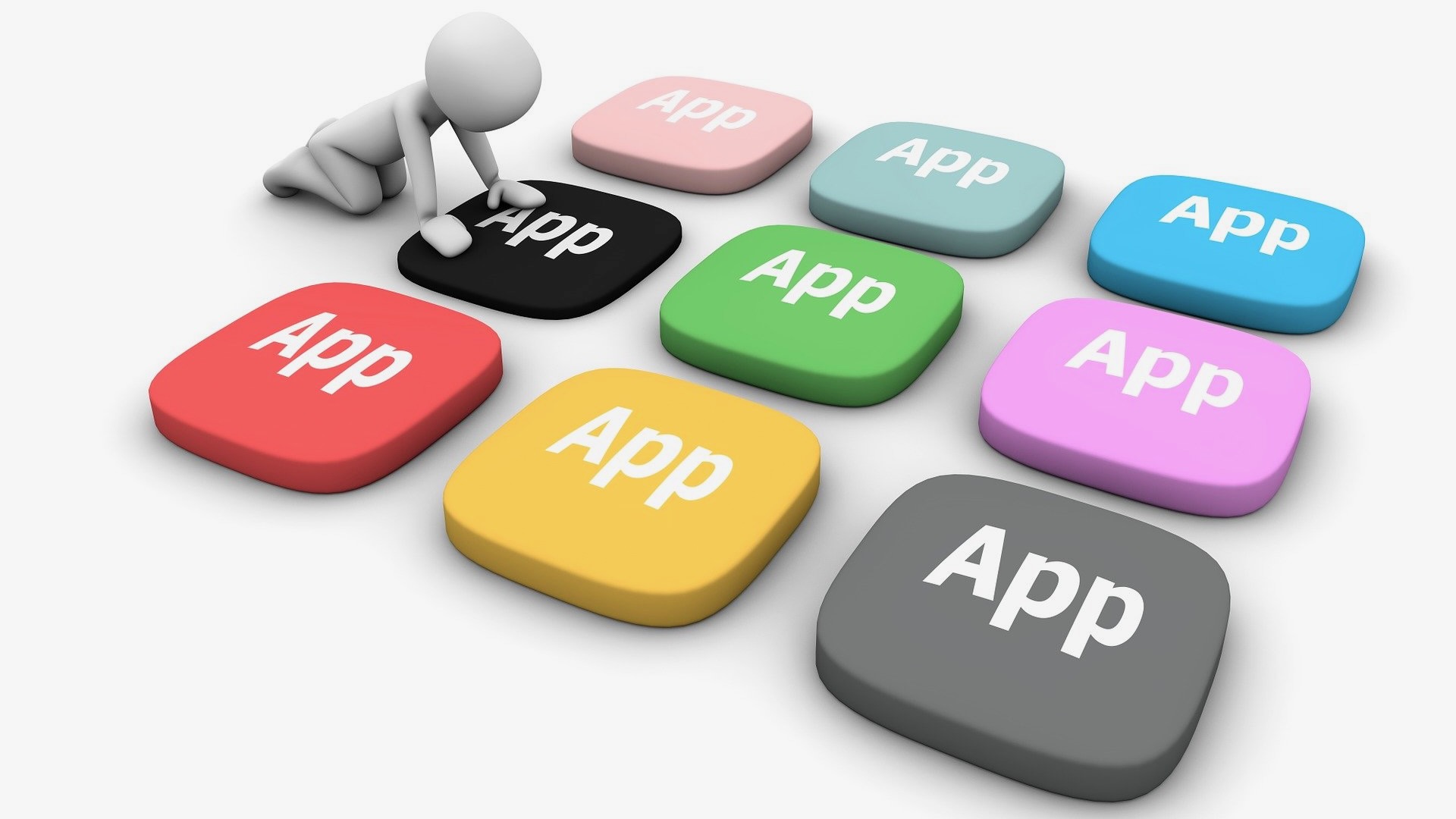
Gone are the days when you had to know how to code in order to build an app.
No-code platforms are software solutions that allow anyone to build web and mobile apps, using visual interfaces and pre-built components. They offer drag-and-drop interfaces, and allow users to create apps simply by arranging and manipulating the pre-built components and connecting them visually.
Since you don’t need any coding knowledge to operate them, these platforms help democratize app development. They enable non-technical users, often called citizen developers, to build all kinds of apps, and automate business processes.
Apps built with no-code platforms can also be modified without much effort. This enables businesses to adapt quickly to changing needs and requirements, and also brings down overall app development costs.
The best no-code platforms of 2025 in full:
Best no-code platform for creating mobile apps
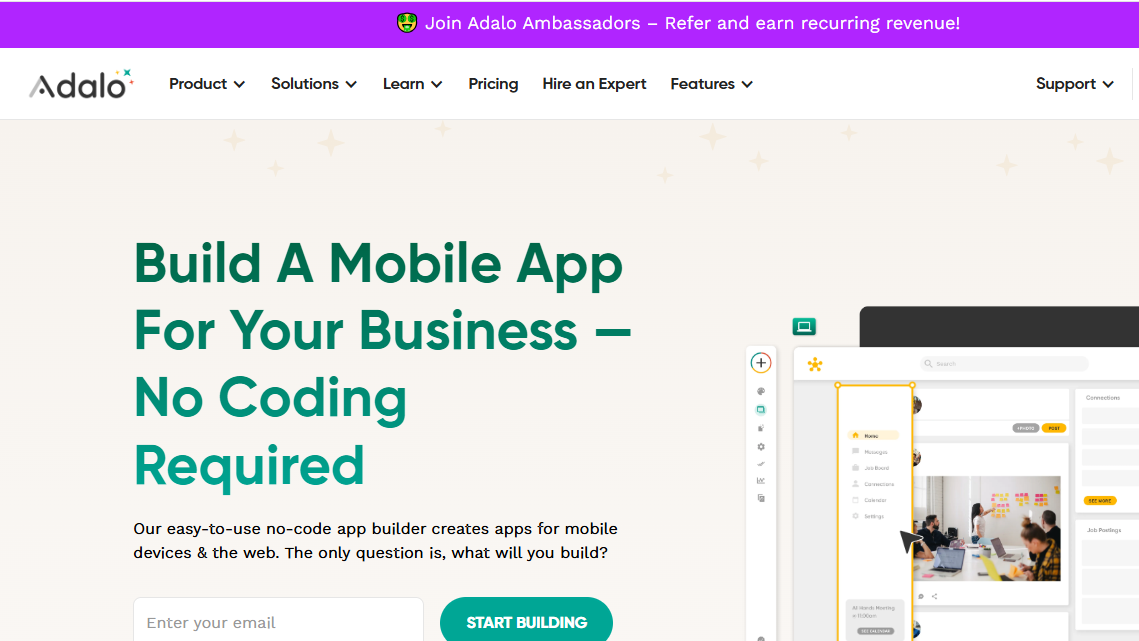
1. Adalo
Our expert review:
Reasons to buy
Reasons to avoid
You can use Adalo’s easy-on-the-eyes interface to create fully functional apps without writing any code. The platform doesn’t have much of a learning curve, and you can use it to build your app once, and deploy it as a native mobile app for both iOS and Android, as well as a Progressive Web App (PWA).
Adalo has been used to create a variety of apps across different industries. The platform’s drag-and-drop builder makes it accessible for beginners, and non-technical users, and simplifies the process of designing, and building apps.
You can visually design your app by simply dragging, and arranging pre-built components onto the screen. It offers several useful pre-built components including lists, forms, navigation bars, buttons, social sign-ins, online payments, and more, that you can use to quickly assemble your app.
You can also easily set up dynamic actions to make your apps interactive, such as link pages with customizable animations, trigger push notifications, manage user logins, and request device permissions.
Adalo also lets you integrate and manage a database, which comes in handy for apps that need to store, fetch, and manipulate data. It has its own database, and can also connect to external databases like Airtable, Google Sheets, and others.
To help you get started, Adalo offers loads of templates for all kinds of use cases such as for coaching apps, ordering apps, e-commerce apps, appointment scheduling apps, and more.
These templates all come with pre-built screens, backend logic, and databases to accelerate the app development process. You can easily customize these templates to match your brand and design needs.
In addition to its built-in features, Adalo also lets you extend the functionality of your apps by rolling in popular third-party services, such as Stripe for payments, Zapier to automate workflows, Google Maps, and a lot more.
Going further, the platform also supports API integrations, to help you connect your apps, and pull data from all kinds of web services.
Adalo offers ample documentation to help first timers get started with the platform. They have everything from beginner’s guides, to over 70 detailed courses to help you turn your ideas into apps. You can also ask for help, showcase your work, and connect with other Adalo users on the platform’s online forums.
You can get started with Adalo via its Free plan, which offers enough features to give you a taste of the platform’s capabilities. Remember though you’ll have to switch to one of the paid plans to unlock more features, and publish your apps.
Best no-code platform for creating elaborate web apps
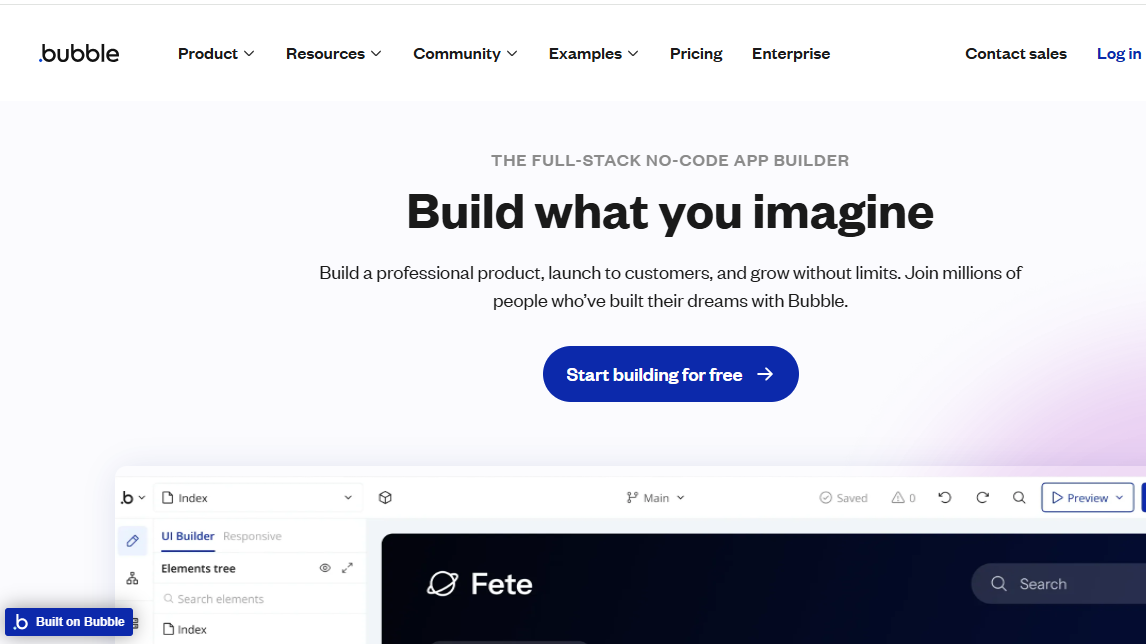
2. Bubble
Our expert review:
Reasons to buy
Reasons to avoid
Bubble is one of the oldest no-code platforms, and offers enough dexterity to allow you to turn complex ideas into innovative apps.
The platform allows for deeply customized workflows with complex conditional logic, which can handle sophisticated business processes. But to make the most of the platform you’ll first have to master its learning curve.
Bubble is a versatile platform, and you can use it to create a wide variety of apps without writing any code. It can help build marketplaces, e-commerce stores, social media networks, software-as-a-service (SaaS) platforms, and more.
You can use the platform’s drag-and-drop editor to design sophisticated user interfaces, and define complex workflows visually, which makes it easier to manage and iterate on intricate features.
The platform has all the UI elements you’ll usually throw in your apps. On top of that it also offers a wide range of tools for more functionality, from payment gateways to analytics, and more.
One of the best things about Bubble’s design editor is that it offers granular control over every visual element. You can use it to control the appearance and style the elements by adjusting their colors, fonts, spacing, shadows, and more. The platform will also let you tweak how elements behave, and resize depending on the user's screen to ensure the apps look good across all screen sizes.
Bubble also has a visual workflow builder that allows you to control how data moves through your app, handle user interactions, and trigger automated actions based on specific events.
The platform has also rolled in AI features throughout the build process. For instance, you can ask its AI to build a blueprint for your app that you can keep refining using AI prompts. You also get an AI bot that can handhold you as you are building your app.
Bubble also has a built-in database editor that you can use not just to manage your app's data, but also define custom data types, relationships, and perform advanced queries, all without writing any SQL.
The platform offers ample resources to help master it. There are written tutorials, videos guides, and loads of courses that cover everything about using Bubble to create apps. You can also take your doubts to the platform’s active forums, and learn from its community of users.
Like all good no-code platforms, Bubble too has a free-tier to give you a taste of its potential, though you’ll have to subscribe to one of its paid plans to publish your apps.
Best no-code platform for creating web apps with AI
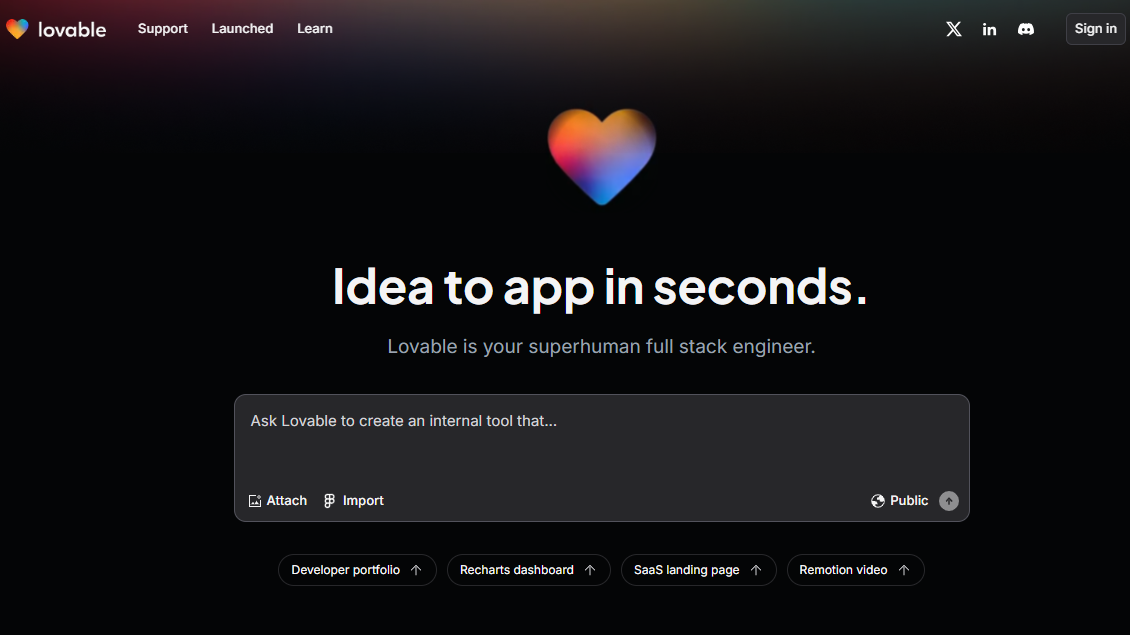
3. Lovable
Our expert review:
Reasons to buy
Reasons to avoid
Sure, visual drag-and-drop interfaces ease app development, but throwing in AI into the mix makes it a whole lot easier. In fact, thanks to natural language processing, you can use Lovable to essentially "talk" your app into existence.
All you have to do is describe your app idea in plain English, and Lovable takes care of the rest. It’ll design, and code the app, and even let you preview it in real time. There’s literally no learning curve involved getting to grips with Lovable’s straightforward chat-based app creation experience.
For instance, you can ask it to “build a marketplace where users can buy and sell sustainable products, with a modern looking UI.” The platform will process your description, and start assembling the core structure of the app, including all necessary backend functionality, along with the UI.
Remember though, Lovable’s success depends on how well you describe your app’s requirements. This is why it’s best to spend some time refining your prompts, ensuring you pass clear and detailed instructions for the AI to deliver better results.
The best thing about Lovable is its verbosity, and live previews. The platform will tell you how it plans to design, and develop your app. After it’s done writing the code, it’ll display a preview of the app. Best of all it’ll keep updating the preview as you continue refining the app, adding features, and functionality.
Lovable relies on Supabase, the open source Firebase alternative, to add comprehensive backend services. You can type your way to integrate Supabase into your app, before asking the platform to add features like a database, user authentication, payments, subscriptions, and more.
Another good thing about Lovable's AI is its debugging abilities. The platform actively monitors the backend as you work on your app, and will flag any issues. The AI will offer to fix most of the issues, and you can always ask it for suggestions to help solve the ones it can’t on its own. If adding some functionality requires something that needs to be done at your end, Lovable will also guide you through its setup.
If you do know how to code, Lovable gives you the option to grab the code for your web app. Unlike some platforms that lock you into their ecosystem, you can use Lovable to sync the code with your GitHub repo. Any changes you make to the code on GitHub will automatically sync to Lovable. If you don’t want to go via GitHub, you can even edit the code on Lovable itself.
Lovable’s free plan limits the AI queries to five times/day for a total of 30 messages/month. This is good enough to get a taste of the platform, before you switch to one of the paid plans that offer more features, and higher usage limits.
Best no-code platform for creating apps with complex logic
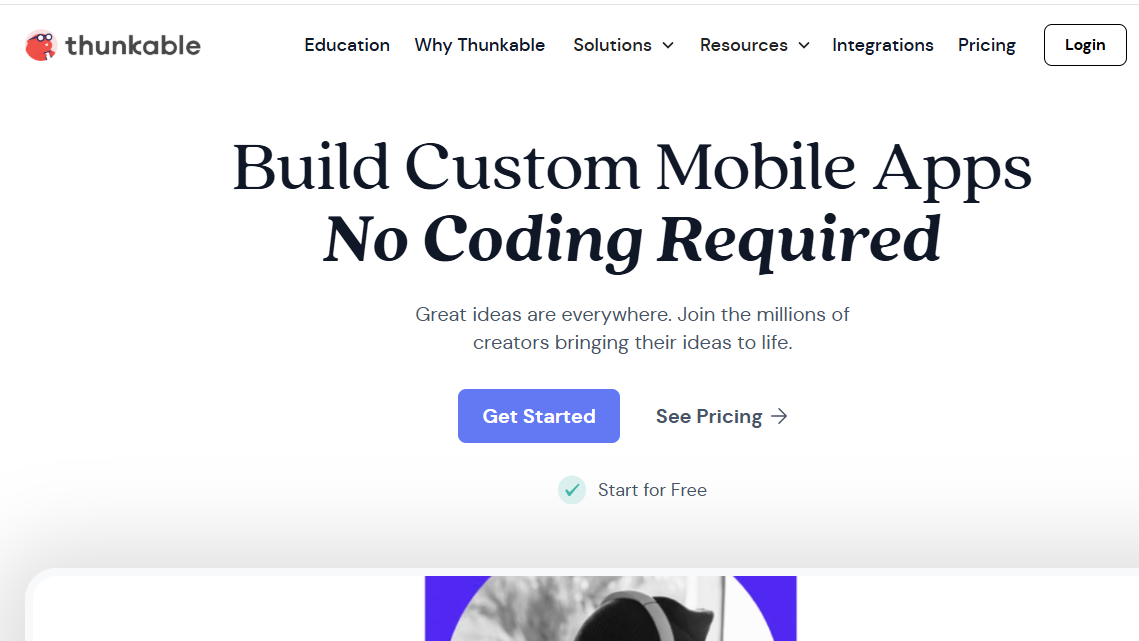
4. Thunkable
Our expert review:
Reasons to buy
Reasons to avoid
If you want greater flexibility when building apps, take a look at Thunkable. The platform has a learning curve, but that’s because it offers more dexterity for building apps than its peers.
One of the USPs of the platform is its visual, block-based programming system, inspired by MIT’s App Inventor and Scratch. You can use it to write complex logic in your apps by building conditional statements, controlling program flow, and executing actions based on specific conditions, all without writing any code.
Thunkable has several kinds of blocks, each of which represents a programming construct. For instance, there are Logic blocks that help define conditional statements, and execute specific actions based on predefined conditions, and events, like button clicks and screen changes.
Then there are Control blocks that are often used together with logic blocks, and allow you to make decisions in your apps. Think of these as writing "if this, do this" and "if this, do this, else do that" statements to execute different actions based on conditions, but through a visual interface.
All the blocks in Thunkable are color-coded. You put them together as if you’re assembling a puzzle. And you can’t go wrong since the pieces only fit together if they make sense logically, which makes the platform even more accessible to non-programmers.
Thunkable also gives access to native mobile hardware, and OS features like the camera, accelerometer, push notifications, bluetooth, and more. You can access these functionalities through App Features blocks.
Best of all, you can use the platform to build native mobile apps for both Android and iOS from a single project, and publish them directly to the respective app stores.
Of course, in addition to its unique block-based programming system, Thunkable also offers all the features you’d expect from a leading no-code platform.
It has a diverse collection of essential user interface components like buttons, sliders, as well as media components, sensors, and more. You can easily drag-and-drop them into your apps, and then customize each element's properties, such as color, size, and layout, to match your app's branding.
The platform also integrates with a wide range of popular services and tools, such as Google Maps, Stripe, Firebase, Airtable, Google Sheets, Xano, RevenueCat (for in-app purchases, and subscriptions), and more.
In addition to its web-based app preview, you can also use the Thunkable Live mobile app to test your app on real devices. The platform offers a tiered pricing structure, including a free tier with limited features that’s good enough to explore the platform, before you commit to one of the paid plans that offer more advanced capabilities.
Best no-code platform for creating multilingual apps
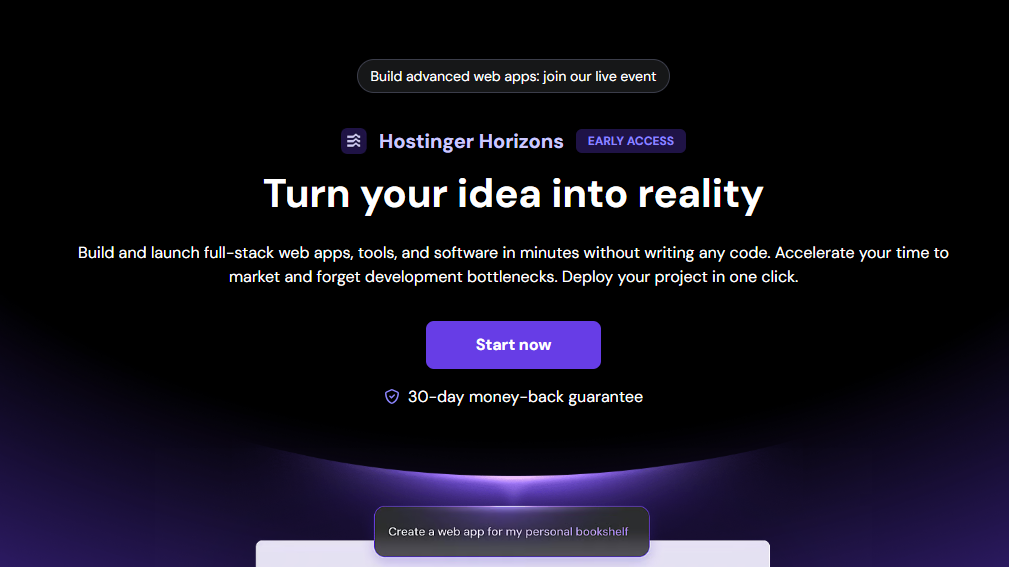
5. Hostinger Horizons
Our expert review:
Reasons to buy
Reasons to avoid
If you want to “converse” your app into existence, just like Lovable, but English isn’t your first language, you can use Hostinger Horizons, which supports over 80 languages.
The platform's AI can understand and respond in any of the supported languages. This means you can describe your app idea in your native language, and the AI will still generate a functioning web app for you.
Not only does the platform’s AI understand multiple languages, but the content of the app itself, such as its UI elements, labels, text, and more, can also be generated in different languages.
For instance, you can tell the AI to “create an appointment booking web app for a yoga studio, where users should be able to view available class times, and book a session. The app should support English and Spanish.”
The AI will first list the implementation steps, and then generate the entire app structure complete with a homepage with class info, booking form, confirmation page, and such. It’ll also add a language switcher to help you switch between the two languages. If it doesn’t, you can always prompt the AI to do so, or perhaps make it appear as a toggle, or a dropdown menu.
Best of all, you can switch languages mid-process, and even localize your app for multiple regions.
For example, you can start building the app in English, then start conversing with the AI in French, and even ask it to generate a German version of the app as well. You can also ask it to create region-specific landing pages with localized offers, and ensure the booking form offers region-specific pricing, and promotions.
The app will add a region navigation bar for easy switching between regions, displays prices in the correct currency, and maintains selected language across region changes. This makes Horizons a wonderful option for non-technical users from different linguistic backgrounds.
The platform will also helpfully suggest ideas to help extend the app, like connecting a database, implementing checkout functionality, and such. Most of these functionalities are possible because of Horizons’ integration with Supabase.
Once you’ve built your app, you can launch it and take advantage of Hostinger’s infrastructure, which offers web hosting, domain services, professional email, and other tools.
Horizons is currently available to all existing users with a Hostinger hosting subscription, who can use it for free, but can only prompt the AI five times per day. To use it professionally though you’ll have to subscribe to one of Horizons’ paid plans.
Best no-code platform for creating apps with existing business data
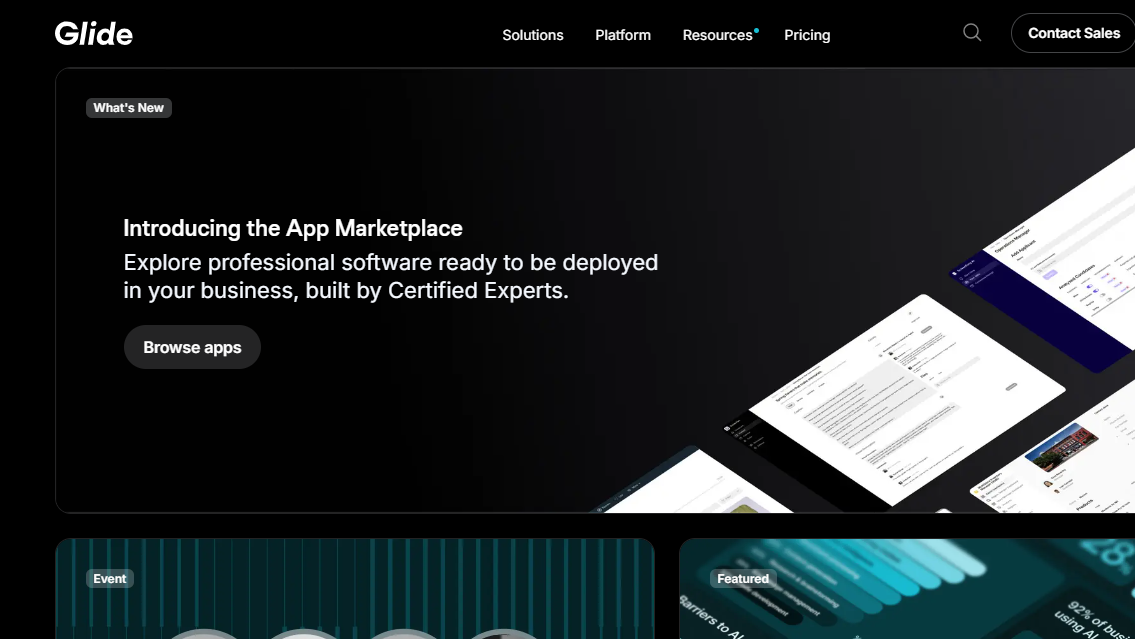
6. Glide
Our expert review:
Reasons to buy
Reasons to avoid
Glide is a no-code app builder that excels at creating web apps from your existing data. If you’ve got business data sitting in spreadsheets, and databases, you can make it visible, and interactive, with user-friendly, dynamic apps without much effort.
Glide can connect to various data sources, from spreadsheets like Google Sheets, Microsoft Excel, Airtable, and data warehouses like BigQuery, to relational databases like MySQL, PostgreSQL, Microsoft SQL Server, and cloud databases like Google Cloud SQL.
Very helpfully, you can use the platform to not just connect to various data sources, but also pool in data from multiple data sources into a single Glide app. So you can, for example, combine legacy data from a PostgreSQL database with customer information stored in Google Sheets.
Interestingly, the platform will keep the data in sync. So any changes in your spreadsheets, or databases are reflected in the app, as well as the other way round.
This makes Glide a good option to create all kinds of internal business tools, like inventory management, CRMs, sales trackers, dashboards, order collection forms, and such.
Oh, and if you’re using Glide to build a data-driven business app from scratch, you can get a jumpstart using one of its templates for common business apps such as CRMs, customer portals, inventory management systems, sales dashboard, and more.
You can also use the platform’s own Glide Tables to store the data, or Glide Big Tables if you need an enterprise-scale database.
After you’ve pointed it to your existing data source, Glide will look through it, and create a basic app structure based on the data, with a handful of screens, each with one or multiple components. For instance, it’ll turn tables into tabs, rows will become collection items, and such.
You can then customize the app's layout, and add more components like buttons, and forms using Glide's intuitive drag-and-drop interface.
Another useful feature is Glide’s role-based access control that allows you to manage who can see and interact with specific parts of your app's data. Depending on your data source, you can either assign roles, like Admin, Editor, or Viewer to users, or define Row Owners, which then control access to different sections of the app and its underlying data.
So if you’re building a CRM, you can ask Glide to ensure Sales Reps can only see/edit their own leads, while Managers can see everyone’s.
Another advantage with Glide is that you don’t have to rely on external automation tools. You can instead use Glide Workflows to automate tasks, though the platform still lets you use external workflow builders like Zapier and Make.
Best no-code platforms FAQs
What can you build with the best no-code apps?
In recent times, no-code tools have emerged as the goto option for quickly creating functional prototypes and minimum viable products (MVPs). They aid developers and businesses rapidly validate ideas, accelerate prototyping, and help bring apps to market a lot faster than with traditional coding.
They are also popularly used to create data dashboards, and knowledge management systems that can store, organize, and retrieve information.
Use of AI by no-code platforms
An increasing number of no-code platforms are incorporating artificial intelligence (AI) capabilities into the app development process. In essence, the use of AI enables users to create full-stack apps by simply describing them in plain English.
Once described, the platforms leverage AI to generate both the front-end, and the back-end for the app. In addition to generating the initial code, some no-code platforms also use AI to flesh out the apps by adding features, and even help troubleshoot and resolve errors.
Choosing the right no-code platform for you
To choose the right no-code platform, begin by defining your apps’ needs, before you evaluate a platform’s features by taking them for a spin with free trials.
When looking at a platform, ensure it integrates with the business tools you already use, and choose a platform that can grow with your business, and handle increasing data and user demands.
Depending on your use case, you might also want to consider security features like data encryption, user authentication, and access control. It’s always a good idea to lean towards platforms that offer good documentation, and active user communities.
How we tested the best no-code platforms
We tested the best no-code platforms by evaluating numerous factors. To start with, we looked at the feature set, the range of tools available, and what size of businesses this would be ideal for. We considered how easy the setup was, the simplicity of the interface, and whether there's sufficient documentation and tutorials for users to utilize necessary options optimally.
We also assessed how well the no-code service integrates with other relevant apps, and checked the overall scalability of the service. We also analyzed whether there were collaboration features for multiple users, and lastly, we judged the quality of the customer service and the different pricing plans available.
Read more on how we test, rate, and review products on TechRadar.
Get in touch
- Want to find out about commercial or marketing opportunities? Click here
- Out of date info, errors, complaints or broken links? Give us a nudge
- Got a suggestion for a product or service provider? Message us directly
- You've reached the end of the page. Jump back up to the top ^
Are you a pro? Subscribe to our newsletter
Sign up to the TechRadar Pro newsletter to get all the top news, opinion, features and guidance your business needs to succeed!
With almost two decades of writing and reporting on Linux, Mayank Sharma would like everyone to think he’s TechRadar Pro’s expert on the topic. Of course, he’s just as interested in other computing topics, particularly cybersecurity, cloud, containers, and coding.
You must confirm your public display name before commenting
Please logout and then login again, you will then be prompted to enter your display name.
